The Best Wireless Mice in 2024
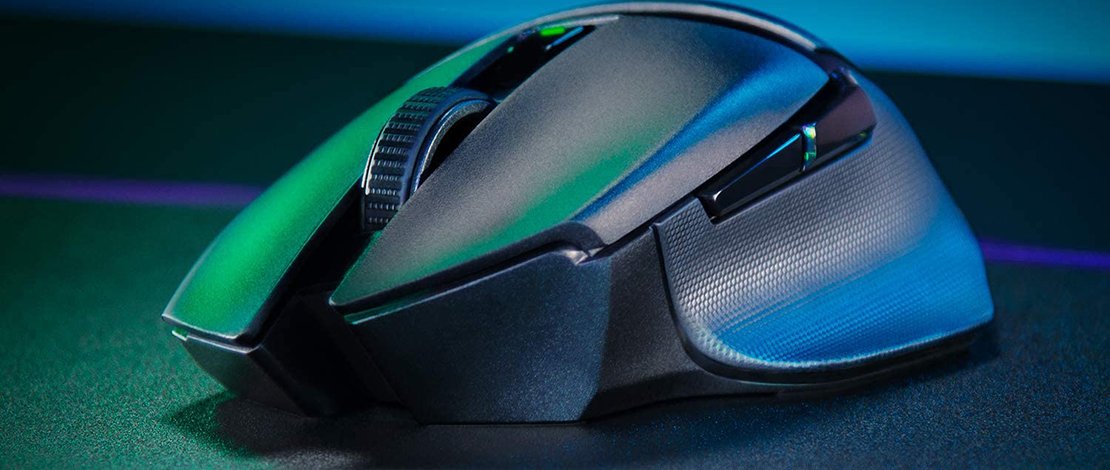
Wireless Mice came a long way during the last decade. Today, they are as capable and as reliable as wired models. The market is bursting with excellent wireless mice models and finding the best wireless mouse is literally impossible. There are so many different models that giving the award to just one (or a few) is impossible.
But we can find the best models in different subcategories. And this we did. Down below you’ll find the best wireless gaming mouse, the best mouse to pair with a laptop or with a Mac, as well as other excellent models that are made for content creators and professionals. Check out our best wireless mice list and then read our wireless mouse buying guide in case you didn’t find your favorite among our picks.
Best Wireless Mice
Razer DeathAdder V3 Pro
The Razer Ergo Champion
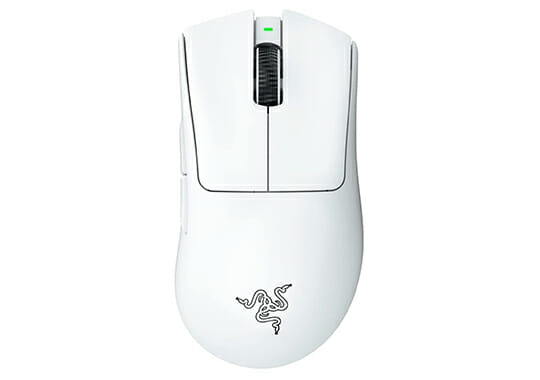
- Razer Focus Pro 30K sensor
- 3rd Gen optical switches
- HyperSpeed wireless technology – 1000 to 4000 Hz
If you like ergonomic mice and want the best wireless technology currently available then look no further than the Razer DeathAdder V3 Pro. This is a mouse trusted by pro gamers playing in eSports championships, therefore, you can trust it with any task you might need to be done.
This is a 64g mouse which is fairly light for its size that comes with a top-end Razer Focus Pro 30K sensor that offers flawless tracking on any surface. The mouse also uses optical switches (3rd Gen) to improve the latency of clicks being registered.
When we say this is the best wireless tech on the market right now, we mean it with all seriousness since the HyperSpeed Wireless offers amazing performance at 1000-4000 Hz polling rate (4000 Hz with the special dongle). What is even more impressive is that it can deliver all of this performance while retaining around 90 hours of battery life while in use.
Overall this is a top-spec ergo mouse for pro gamers, and if they can use it for becoming champions you can probably use it for anything.
- The best ergo mouse on the market right now
- eSports-ready wireless performance
- The weight is decent for the size of the mouse
- Good battery life
- To get the 4000Hz you need to use the not-included dongle that you need to purchase separately
Logitech G502 X Plus Lightspeed
The G502 Successor
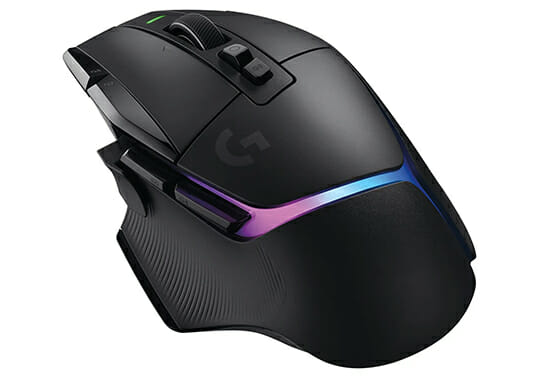
- Hero 25K sensor
- Opto-mechanical switches
- Lightspeed wireless technology
- 106g
The Logitech G502 is probably one of the most recognized mice that has ever been produced and Logitech decided to refresh it by giving it some new tech. This is now a wireless mouse that uses Logitech’s Lightspeed wireless tech which is one of the best in terms of latency and consistency.
The new sensor in the G502 X Plus Lightspeed is the Hero 25K which is used in eSports mice so you can do pretty much anything with this mouse with precision. Logitech also decided to spice up the look of the mouse as well by including RGB which is customizable from the G Hub software.
The new G502 also uses new hybrid optomechanical switches called Lightforce switches which in Logitech’s words help with response times and reliability. The mouse boasts 120 hours of battery life with the RGB off and 37 with the RGB on.
The only real downside of the new G502 is the weight which sits at 106g. This has been traditionally the biggest issue with the original mouse as well and it seems Logitech simply decided that the G502 will stay a heavyweight. If 100+g is not an issue for you though then using this mouse will be a joy!
- An all-rounder mouse that can be used for gaming and productivity
- The shape and design language has become a staple for many people
- The mouse uses top Logitech specs, therefore, can be used for gaming and productivity tasks
- 106g in our current market is quite a bit heavier than most other gaming designed mice with top specs
Logitech MX Master 3S
The Productivity King
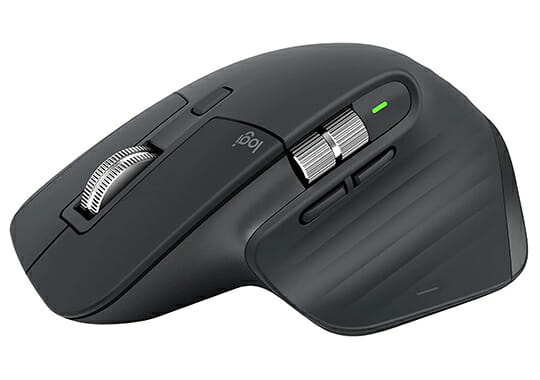
- 8K DPI sensor
- Silent mouse switches
- Multiple-device pairing
The Logitech MX Master 3S comes from a long line of MX Master productivity mice that were specifically designed with office work in mind. This mouse uses an 8K DPI sensor to track on any surface and achieves wireless connectivity through the 2.4GHz Logi Bolt receiver or Bluetooth Low Energy.
To enhance the productivity aspect of the MX Master 3S you can pair it with multiple devices (up to 3 devices) to make your workflow seamless between them. One of the features that make this mouse unique is the Magspeed scrolling allowing for quick page movements when you need to find that one specific line in your datasheet.
Overall this is an ergonomic mouse designed for work that makes sense for most office dwellers who need a trusty input device.
- The shape makes the mouse comfortable to use
- Flawless pairing with 3 devices is a big bonus for people working with multiple tools
- Enough buttons and binds for any kind of custom workflow
- 125Hz polling rate
- The magnetic scroll wheel on certain copies seems to be exhibiting weird behavior
Microsoft Surface Arc Mouse
Stylish Wireless Mouse With Minimalistic Design
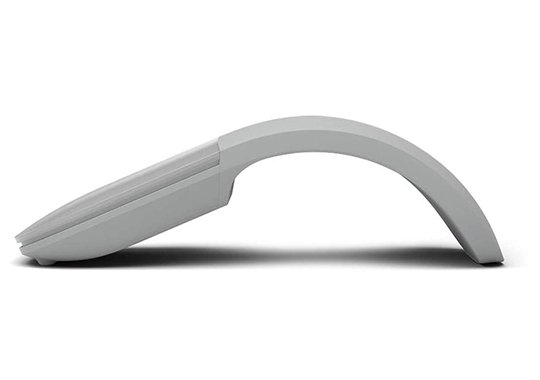
- Number Of Buttons: Zero Physical Buttons
- Wireless Connectivity: Bluetooth
- Sensitivity And Pooling Rate: Undisclosed
- Battery Life: Up To Six Months
- Weight: 82 grams
The Surface Arc Mouse from Microsoft is a stunning piece of technology. The minimalistic design combined with the high arch of the mouse gives it a stylish look that can turn heads. The minimalism is carried to the buttons and scroll wheel, which cannot be found on this mouse. Instead, you have a large touch-sensitive area with left and right sides working as buttons and the upper part of it working as a horizontal and vertical scroll wheel.
This isn’t the best design since the feedback on button clicking isn’t the best. Vertical scroll works great but horizontal scrolling is largely problematic. Finicky, and imprecise. High arch makes the mouse pretty comfortable to use but lack of extra buttons means that both gamers and professionals such as content creators won’t find this mouse very usable.
The Surface Arc Mouse uses two AAA batteries for power and they can last for as long as half a year, which is amazing battery life. The downside is that you have to keep extra batteries with you at all times and that there isn’t an option for recharging the mouse. Bluetooth connectivity is mostly stable but can be unresponsive at times.
Overall, the Surface Arc Mouse is a stylish mouse that’s great for users who want a great looking mouse that has all the basic functions and that’s highly portable. The lack of extra keys, solid but not great wireless performance and lack of customization will make this mouse a pass for both gamers and professionals.
- Exemplary Minimalistic Design
- Comfortable To Use
- Excellent Battery life
- Great Portability
- No Extra Buttons
- Buttons Cannot Be Customized
- Finicky Wireless Performance
- Horizontal Scrolling Has Issues
Logitech Lift
For the Vertical Mouse Lovers
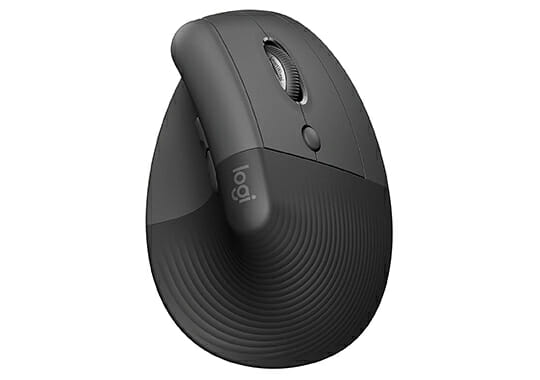
- Vertical ergonomic design
- 57 degrees angle
- Multiple-device pairing
Vertical mice are definitely an acquired taste but if you are someone that enjoys these quirky looking devices the Logitech Lift was made for you. The main selling point of the Lift is the shape that raises your hand at 57 degrees to maintain comfort. The shape takes a bit to get used to, but if you have used vertical mice before this will be a seamless transition.
Talking about seamless transitions, the Logitech Lift can flow between 3 multi-OS devices to enhance your workflow across platforms easily. It can do this due to a wireless connection through the Logi Bolt receiver or Bluetooth Low Energy.
This is not a mouse for everyone, but if you do enjoy vertical mice for productivity work, then this is an excellent choice.
- The main attraction of this device is the vertical ergonomic shape
- Can be used as a multi-platform productivity input device
- Customizable buttons for specific tasks
- While the shape is unique it might not work for many people who are used to traditionally shaped mice, therefore, limiting the potential market
Razer Orochi V2
The Best Budget Wireless Mouse
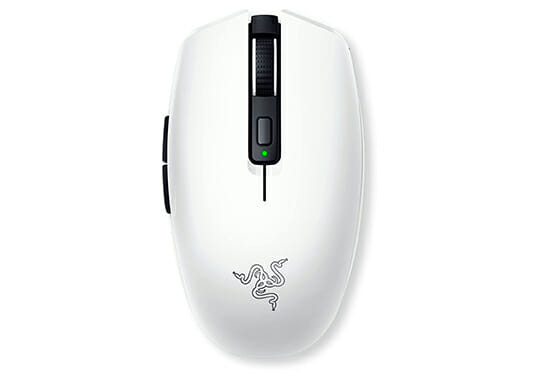
- 2.4GHz and Bluetooth wireless
- PixArt 3369 sensor
- Razer mechanical switches (Kailh GM 4.0)
- Swappable top shell
If you are looking for an alternative for the classic Logitech G305 shape or you are simply interested in a very good budget wireless gaming mouse option then the Razer Orochi v2 fulfills all of those requirements.
This mouse is quite small therefore it is well suited for finger-tip grip or claw grip if your hands are also on the smaller size. The mouse runs in 2.4GHz wireless but can also connect using a Bluetooth connection. While this is great we would not recommend using Bluetooth since it is less stable and introduces motion delay.
The mouse runs at 1000 Hz polling rate with no issues and has a flawless PixArt 3369 sensor. The weight of the mouse depends on what kind of battery you will put inside of it since it can run both with a single AAA or single AA battery. The weight with those configurations ranges around 75g which is a lot lighter than the sub 100g G305.
Another surprising aspect of the mouse is the fact that it uses Razer mechanical switches that are clones of the Kailh GM 4.0s. These are very tactile and crisp when actuated. The Orochi v2 also comes with a party trick and namely the ability to change the shell to a custom one with special designs.
This doesn’t functionally change the mouse but it does give it a bit of personality which is nice to see on a budget product. Overall a great mouse for someone that needs a small wireless mouse!
- The mouse shape is perfect for fingertip grip or claw grip with smaller hands
- The sensor and wireless capability is top-notch (although not as good as the premium mice)
- The weight of the mouse is acceptable
- The swappable top shell makes it a unique mouse in terms of customizability
- Not the best weight for a wireless small mouse
- The lack of an internal rechargeable battery is holding the mouse back
Apple Magic Mouse
A Good Choice for Mac Users
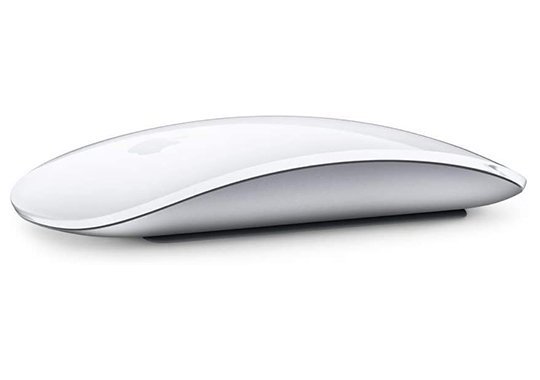
- USB Type-C
- Bluetooth connectivity
- Multi-Touch surface
- 99-gram mouse
The Apple Magic Mouse is the newest iteration of their mouse model but unfortunately, there don’t seem to be any major updates to the mouse. The only change is the fact that the mouse uses USB Type-C instead of Type A.
Aside from this, the mouse uses the same laser sensor and Bluetooth connection to pair with your Apple devices. The mouse has no physical clicks but instead uses a Multi-Touch surface that emulates clicks and allows you to perform simple gestures like swipes to trigger certain events.
The shape of the mouse is still quite awkward to hold comfortably but it is useful nonetheless if you have smaller hands. The charging port is still on the bottom of the mouse which renders it unusable during the charging process which is quite a hassle but at least you will not have to charge it often because the battery lasts for quite a while.
The mouse is pretty heavy at around 99 grams and the mouse feet are quite bad but for simple office work it will do just fine.
The real appeal of this mouse is of course the minimal design so if you are gunning for a clean white aesthetic for your desktop this might be the choice for you.
- The multi-touch surface allows for easier office work
- The battery does last for quite a while
- The flawless pairing with Mac products is nice
- The look of the mouse is quite unique and well designed
- Uncomfortable shape
- Charging port on the back of the mouse
- Bluetooth connectivity
- Expensive price for not the best experience
Logitech MX Ergo Wireless Trackball Mouse
The Best Wireless Trackball Mouse
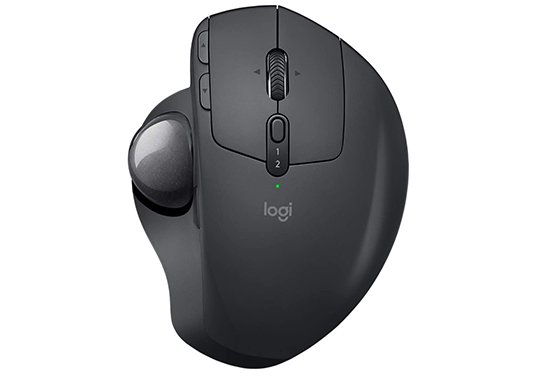
- Number Of Buttons: Eight Buttons
- Wireless Connectivity: USB Dongle, Bluetooth
- Sensitivity And Pooling Rate: 2048 DPI; Undisclosed
- Battery Life: Up To Four Months
- Weight: 259 Grams
The trackball mouse market is a small niche populated by a few dozen models. When it comes to wireless trackball mice, the niche is even smaller. And the MX Ergo Wireless is the king of the hill. This is the best wireless trackball mouse on the market and despite its high price, it’s worth it if you like using the trackball instead of moving your mouse around.
First of all, this mouse is seriously comfortable. You can use it for hours without feeling any strain on your wrist. It can tilt for about 20 degrees to enable even higher comfort but that position can lead to some wrist strain during long sessions. The mouse’s also very large. This isn’t a downside since you don’t have to move it around all the time, allowing users with extra-large hands to have a very pleasant experience using this mouse.
The trackball performance is flawless. The adjustment period is one to a couple of days. After that, navigating through any desktop operating system with a trackball will be almost as precise as using a regular mouse. The mouse is equipped with a fair share of programmable buttons. You can use Logitech’s settings app to tweak their function along with a few other settings. A button next to the trackball puts it in the precision mode for precise movements, which can be handy in many apps.
The mouse can last for about four months on a single charge and the battery can be recharged via a Micro USB port. The mouse can work both via USB dongle or Bluetooth and while Bluetooth connection can be spotty when used with regular mice, the unique nature of this mouse makes Bluetooth connection as stable and the 2.4GHz radio one.
Overall, the Logitech MX Ergo Wireless is a fantastic trackball mouse. It has an amazing build quality and is great to use on a daily basis if you can adjust to using the trackball. Notable negatives include the Micro USB port instead of a USB-C, along with a high price.
- Excellent Ergonomics
- Superb Comfort
- Trackball Doesn’t Require Long Adjustment Period
- Lots Of Programmable Buttons
- Long Battery Life
- Micro USB Instead Of USB-C
- High Price
Microsoft Surface Mobile Mouse
The Best Wireless Mouse For Laptop
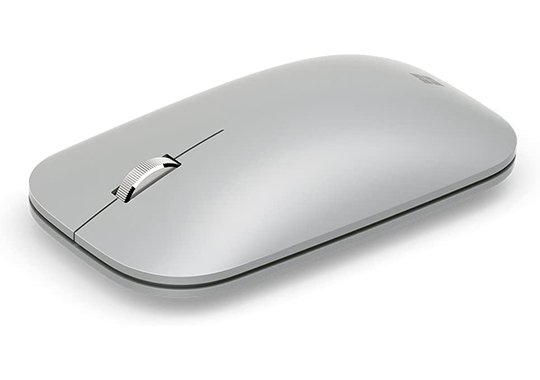
- Number Of Buttons: Three Buttons
- Wireless Connectivity: Bluetooth
- Sensitivity And Pooling Rate: 2048 DPI; Undisclosed
- Battery Life: Up To Four Months
- Weight: 78 Grams
Microsoft Surface Mobile Mouse is a tiny and portable wireless mouse with a very affordable price that can be the best friend of your laptop. It’s thin and light but not as small as some other travel mice. It’s instead medium-sized and quite wide, allowing users to hold it with an entire hand while using it, increasing comfort. It’s not super comfortable like some other mice on this list but it’s great for a portable laptop mouse.
The build quality is excellent. The plastic used is sturdy and the body of the mouse feels very rugged. The metal scroll wheel feels indestructible. This mouse can be thrown into any bag or a backpack and it will survive any travel. The mouse doesn’t have any extra keys. You only get the left and right-click along with the clickable scroll wheel and that’s it. That would be a downside for a larger and more expensive model but for an affordable laptop mouse that’s not a negative.
Two AA batteries can power the mouse for a whole year before needing replacements, which is excellent battery life. Just remember to always have two extra batteries inside your laptop bag in case the batteries die when you least need it. The Bluetooth connection is stable most of the time, although you’ll notice a few glitches during the day.
Overall, this is an amazing and very affordable laptop wireless mouse. It has a sleek design, it’s light and very comfortable for a portable mouse, it has a superb battery life, and its Bluetooth connection is stable 99 percent of the time. On the other hand, the mouse doesn’t have USB dongle 2.4GHz wireless connectivity, extra keys, or a customization app.
- Slick Design
- Affordable Price
- Long Battery Life
- Suited For Users With Larger Hands
- Excellent Portability
- No Customization App
- Supports Only Bluetooth Connection
- No Extra Keys
How To Choose The Best Wireless Mouse
Picking the best wireless mouse starts from you. Before you start looking for a wireless mouse, set your needs and expectations. Do you want a gaming mouse or an ergonomic mouse? What’s your budget? Do you need a mouse with a laser or an optical sensor? Would you rather get a mouse that has a rechargeable battery or a device powered by a classic AAA/AA battery? Does your workflow require a mouse that can be connected to one or more devices at the same time?
These and other features are important for selecting a wireless mouse that will suit your needs. A mouse that will be perfect for you. Aside from these major points to look out for, wireless mice have other, smaller features that can also play important roles regarding their ergonomics, ease of use, and durability. Let’s cover all of these features in detail.
Wireless Connectivity
The first and most important feature in every wireless mouse. Back in the day, wireless mice had inherent disadvantages over their wired brethren. They had noticeable lag and their batteries weren’t greatest. Today though, the lag is reduced greatly, up to a point where even the most competitive gamers can use a wireless mouse.
When it comes to connection types, we have two main standards. The first one is a radio-based 2.4GHz connection that includes a small USB receiver that has to be hooked to a device you want to use the mouse with. It’s here for more than a decade and it’s the main way for wireless mice to connect to computers.
The second type of connection is Bluetooth. The advantage of Bluetooth connection is that it doesn’t require a receiver, in most cases. This allows wireless mice that use Bluetooth to connect not only to PCs and Macs but also to smartphones, iPads, and other devices that support Bluetooth. The downside is that Bluetooth connection can be spotty and it has a higher amount of lag compared to the 2.4GHz wireless connection.
Wireless mice can use a USB dongle, Bluetooth, or both, the same as wireless keyboards. If you need a mouse to use with your laptop feel free to use any of the two. If you need a mouse to use with multiple devices get one that supports both wireless connections since they can connect with multiple devices at the same time. Also, if you need a gaming mouse, it’s better to get one that uses 2.4GHz radio connection or one that has both options.
Battery Life And Recharging The Mouse
The second most important thing about every wireless mouse is battery life. Here, we also have two main technologies used – rechargeable batteries and disposable ones. Each has its own pros and cons.
For instance, rechargeable batteries will deplete sooner but they can be recharged with a cable (Micro USB or USB-C), allowing users to keep using the mouse, even when it’s charging. Today, there are also some models that can be recharged wirelessly. They use wireless charging mousepads that utilize Qi wireless charging or a proprietary standard such as the Logitech’s Powerplay.
Mice using disposable AAA or AA batteries can work for months, years even, on a single battery. But they cannot be used once the battery depletes. You have to replace the battery and if you don’t have an extra one lying around that can be an issue. Also, AAA and AA batteries are heavy and they can make those mice heavier than those using rechargeable batteries.
Gaming Or Non-Gaming Mouse
There are lots of differences between gaming and non-gaming wireless mice. First usually have more buttons, higher DPI sensors that are more responsive (more on that later), and other features that (in most cases) cannot be found on regular mice.
Stuff such as buttons for changing the precision of the sensor, removable weights for precise tweaking of the weight of the mouse, or backlighting. Non-gaming mice come in a variety of shapes and sizes.
You have small mice that are very portable and made to be used with laptops. You have ergonomic mice that are shaped in such a way to fit perfectly in the hand, or that have a unique design to reduce the strain on your wrist, such as the vertical mouse. You also have regular mice made for universal usage, which can be used for gaming and work.
If you’re primarily a gamer, a gaming mouse is usually the right way to go. They are suited for gamers and have the most precise and responsive sensors. If you’re a casual gamer who also does lots of work on their computer, you can go both with a gaming or non-gaming mouse. It boils down to what’s important to you.
Mouse Ergonomics
Wireless mice, as well as regular models, have different designs. Some feature ambidextrous shape and can be used both by the left and right-handed persons. Others feature an ergonomic design that features a resting area for the thumb or curves that follow the way fingers grip the mouse. An ergonomic mouse cannot be used by lefties since it doesn’t have an ambidextrous design.
No matter whether you prefer regular or ergonomically shaped mice, both come in various sizes. This means that even if a mouse follows your preferred design, it might be too small or too large for your hands. This is why the best way to test whether a mouse is comfortable is to try it out yourself.
Do note that most mice models can cause wrist strain. If you’re experiencing issues maybe you should try a vertical mouse, which is designed to be held in a different way, a way that prevents the wrist from being in an unnatural position that leads to it being strained and damaged.
Mouse Button Layout
Back in the day, every mouse would have just two buttons, three once the scroll wheel became a thing. Nowadays many models feature at least five buttons, with two buttons being placed above the thumb. These are used as back and forward buttons in browsers and some apps.
Gaming mice come with these five buttons and usually a sixth one used for changing the DPI. But there are models with even more buttons. For instance, you have gaming mice made for MMO games that feature a dozen or more buttons. And some ergonomic models feature an extra scroll wheel, or unusual additions such as a trackball.
Mouse Size, Weight, And Portability
The weight thing isn’t so much important unless you want a gaming mouse. Gaming mice are usually lighter than standard models. There are even models with a honeycomb body that further reduces the weight and allows the mouse to be moved around at an astounding pace. But you won’t see these models in the wireless market.
Nevertheless, wireless gaming mice are still lighter than standard mice. If you’re looking for a gaming wireless mouse, look for weight and pick lighter models since they are easier to move around and thus easier to aim with.
When it comes to size, look for a mouse that comfortably fits your hand. This can be tricky since you’ll have to try them out in person, but picking a mouse with just the right size is important. This is a device you’ll use for hours each day and getting a model that’s too large or (especially) too small for your hands will make it uncomfortable to use in the long run.
Finally, portability. Some models are made for laptops and are as light and compact as possible. Luckily, most wireless mice are light enough to be carried around in a laptop bag but some models aren’t really made to be carried around all the time.
Laser or Optical Sensor
The age-old decision between the laser of the optical sensor has a pretty simple answer. If you’re looking for a gaming mouse, those come mostly with optical sensors so get one with an optical sensor. Are they better than models with laser sensors? For gaming yes, they are.
You see, sensors on both types are the same but the illumination is different. You have LEDs (optical) and lasers in laser mice. LEDs only light up the surface and do not bombard the sensors with unnecessary data. Lasers, on the other hand, pick up more data about the surface since they can penetrate it.
This means that laser mice work great with hard surfaces, even glass. But when combined with popular pads made of cloth, they scan for the structure of the cloth, picking up ridges and folds and making the sensor behave like it’s traveling across an uneven surface. This is bad for gaming since even the smallest variation from even, straight-line movement can mess up your aim.
But if you need a mouse for work, it doesn’t matter whether you get an optical or a laser model. In fact, laser ones are better since they can work pretty well on a variety of surfaces. So, if you’re looking for a gaming mouse, get a model with an optical sensor. Everyone else, try getting a laser mouse.
DPI and Pooling Rate
Dots per inch is the measurement of mouse sensitivity. Higher DPI means the mouse will detect smaller movements. Gaming mice can have sensors that reach as high as 20,000 DPI. This is, of course, too sensitive for all except people gaming on a 75-inch 8K TV. Remember that about 5,000-8,000 DPI sensor is enough for most gamers. If you’re buying a mouse for work, even something like 1,000 DPI should be enough for comfortable use.
The pooling rate represents the number of times the mouse sensor reports its position to your computer. The higher the better. If you’re looking for a gaming mouse, get a model that has a pooling rate of 1,000 hertz since that’s the standard on the gaming mouse market. On the other hand, those looking for a mouse for work or other, non-gaming purposes, don’t have to care about stuff like pooling rate.
Customization And Compatibility
Many mice come with software that can be used for tweaking various settings and for customizing different things. You can change what buttons do, change backlighting effects, and much more. In most cases, gaming mice have the most detailed customization software but you can find models with excellent software that aren’t made for gaming.
Finally, there’s the issue of compatibility. For instance, wireless mice using Bluetooth can, in theory, work with all iOS and Android devices since all smartphones and tablets have Bluetooth chips. But in practice, many models don’t support mouse control. It’s better to check whether a device you own is compatible with the specific mouse or whether it supports mouse control before you decide to buy a particular mouse.